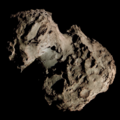C/1886 J1 (Brooks)
 Telescopic view of Comet Brooks, drawn by Edward E. Barnard from Nashville, Tennessee on 7 May 1886.[1] | |
| Discovery[2] | |
|---|---|
| Discovered by | William Robert Brooks |
| Discovery site | Phelps, New York |
| Discovery date | 1 May 1886 |
| Designations | |
| 1886 III, 1886b[3] | |
| Orbital characteristics[4][5] | |
| Epoch | 9 May 1886 (JD 2410035.5) |
| Observation arc | 19 days |
| Number of observations | 19 |
| Aphelion | ~4,200 AU (inbound) |
| Perihelion | 0.842 AU |
| Semi-major axis | ~2,100 AU (inbound) |
| Eccentricity | 0.99959 (inbound) 1.00020 (outbound) |
| Inclination | 100.21° |
| 289.36° | |
| Argument of periapsis | 38.593° |
| Last perihelion | 4 May 1886 |
| Earth MOID | 0.067 AU |
| Jupiter MOID | 0.720 AU |
| Physical characteristics[6] | |
| Comet total magnitude (M1) | 4.9 |
| 7.0–8.0 (1886 apparition) | |
C/1886 J1 (Brooks) is a parabolic comet that was observed between May and June 1886. It was William Robert Brooks's second comet discovery in 1886, and his fifth overall.[1]
Observational history
[edit]Just two days after discovering his first comet of the year,[a] Brooks spotted another one within the constellation Pegasus on 1 May 1886,[b] which he described as "having a small, but bright and stellar head, and a conspicuous tail".[2] By 3 May, E. A. Lamp observed the comet from Kiel, noting that it was "very bright in twilight with a notable tail and yellowish nucleus".[8] At the time, the comet was around magnitude 7.0–8.0 in brightness.[6]
Orbit
[edit]A number of astronomers, including Adolf Berberich,[9] Edgar Frisby and H. V. Egbert,[10] Rudolf F. Spitaler and Hermann Oppenheim,[11] and Giovanni Celoria,[12] calculated the orbit for C/1886 J1, concluding with a parabolic solution using the observations taken within a span of 19 days. Later, in 1908 and 1909, Caroline E. Furness and Emma P. Waterman,[13] as well as Hermann Kobold,[14] would revise their solutions into a weakly hyperbolic trajectory, indicating that the comet reached perihelion on 4 May 1886 at a distance of 0.842 AU (126.0 million km) from the Sun.
Potential meteor shower
[edit]While working on his own orbital calculations for the comet, Edmund Weiss noticed that the ascending node for C/1886 J1 passed within 0.067 AU (10.0 million km) from Earth's orbit, suggesting a possibility of a meteor shower that may occur in a radiant within the constellation Phoenix.[c] However, no such meteor shower activity was detected.[15]
References
[edit]Notes
[edit]Citations
[edit]- ^ a b E. E. Barnard (1886). "Brooks' Second Comet, 1886". The Observatory. 9 (113): 278. Bibcode:1886Obs.....9..278B. ISSN 0029-7704.
- ^ a b W. F. Brooks (1886). "Entdeckung zweier neuen Cometen von Brooks". Astronomische Nachrichten (in German). 114 (14): 223–224. Bibcode:1886AN....114..223.. doi:10.1002/asna.18861141405.
- ^ "Comet Names and Designations". International Comet Quarterly. Retrieved 2 July 2025.
- ^ "Barycentric Osculating Orbital Elements for Comet C/1886 J1 (Brooks) in epoch 1800 and 2200". JPL Horizons On-Line Ephemeris System. Jet Propulsion Laboratory. Retrieved 2 July 2025. (Solution using the Solar System's barycenter (Sun+Jupiter). Select Ephemeris Type:Elements and Center:@0)
- ^ "C/1886 J1 (Brooks) – JPL Small-Body Database Lookup". ssd.jpl.nasa.gov. Jet Propulsion Laboratory. Retrieved 2 July 2025.
- ^ a b c d G. W. Kronk (2003). Cometography: A Catalog of Comets. Vol. 2: 1800–1899. Cambridge University Press. pp. 571–573. ISBN 978-0-521-58505-7.
- ^ "C/1886 H1 (Brooks) – JPL Small-Body Database Lookup". ssd.jpl.nasa.gov. Jet Propulsion Laboratory. Retrieved 3 July 2025.
- ^ E. A. Lamp (1886). "Beobachtungen des neuen Cometen Brooks 2". Astronomische Nachrichten (in German). 114 (15): 237–238. Bibcode:1886AN....114..237L. doi:10.1002/asna.18861141509.
- ^ A. Berberich (1886). "Elemente und Ephemeriden der Cometen 1886 … (Brooks 1 und Brooks 2)". Astronomische Nachrichten (in German). 114 (17): 303. Bibcode:1886AN....114..303B. doi:10.1002/asna.18861141707.
- ^ E. Frisby; H. V. Egbert (1886). "Elemente der Cometen 1886 … (Brooks 1 und Brooks 2)". Astronomische Nachrichten (in German). 114 (17): 303. Bibcode:1886AN....114..303E. doi:10.1002/asna.18861141708.
- ^ R. F. Spitaler; H. Oppenheim. "Elemente und Ephemeriden des Cometen 1886 … (Brooks 2)". Astronomische Nachrichten (in German). 114 (17): 301–302. Bibcode:1886AN....114..301S. doi:10.1002/asna.18861141706.
- ^ G. Celoria (1887). "Osservazioni ed orbita della Cometa 1886 III". Astronomische Nachrichten (in Italian). 117 (1): 9–10. Bibcode:1887AN....117....9C. doi:10.1002/asna.18871170106.
- ^ C. E. Furness; E. P. Waterman (1908). "Definitive Orbit of Comet 1886 III". Astronomische Abhandlungen als Ergänzungshefte zu den Astronomische Nachrichten. 14: 26–35. Bibcode:1908AAAN...14...26F.
- ^ H. A. Kobold (1886). "Über die Bahn des Kometen 1886 III". Astronomische Nachrichten (in German). 182 (3): 33–42. Bibcode:1909AN....182...33K. doi:10.1002/asna.19091820302.
- ^ a b E. Weiss (1886). "Notiz über den Radiationspunkt von Meteoren aus der Bahn des Cometen 1886… (Brooks 2)". Astronomische Nachrichten (in German). 114 (23): 399–400. Bibcode:1886AN....114..399W. doi:10.1002/asna.18861142308.
External links
[edit]- C/1886 J1 at the JPL Small-Body Database


